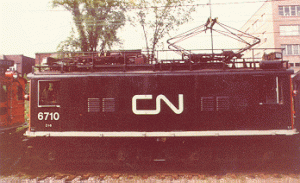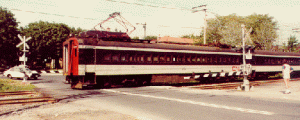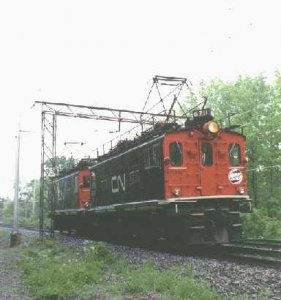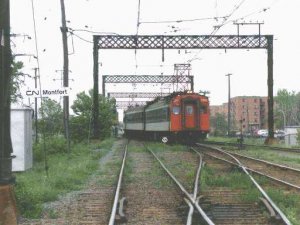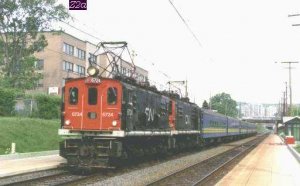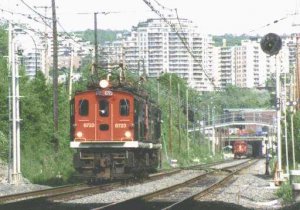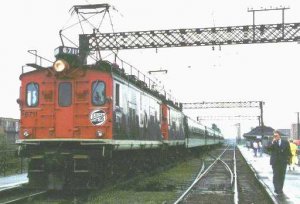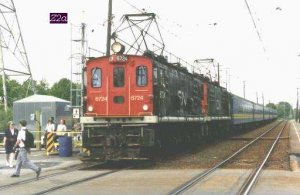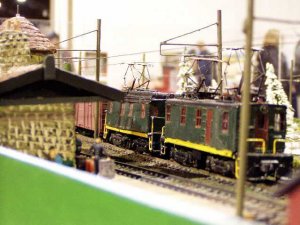C N Montreal-Deux Montagnes Electric operation for C N 1
Hi Folks and CN 1
This will be ongoing as info is posted .
Please feel free to post any Pictures of this operation or Models + info.
Thanks.
Chapter 10: The Montreal/Deux-Montagnes Commuter Train
By Stéphane Plante
The Canadian Northern Railway Company To understand the history of our railway, one has to go back to the turn of the century. At that time, in 1894 to be exact, two young men, McKenzie and Mann, originally from Southern Ontario, created the Canadian Northern Railway Company. Concentrating most of its activities in the Prairies, the company expanded rapidly, especially during the boom years just before the First World War.
The Canadian Northern Railway
Company To understand the history of our railway, one has to go back to the turn of the century. At that time, in 1894 to be exact, two young men, McKenzie and Mann, originally from Southern Ontario, created the Canadian Northern Railway Company. Concentrating most of its activities in the Prairies, the company expanded rapidly, especially during the boom years just before the First World War.
At the beginning of this century, the company acquired a train service network between Quebec City and Hawkesbury. In 1912, in order to reduce travel time between the two cities, Canadian Northern drilled a 5.2 km tunnel through the volcanic rock of Mount Royal. From a 5.5 hectare piece of land purchased by the company to build a station which would later become Central Station, the tunnel opened at the other end on a garden city designed by C.No.R. (Canadian Northern Railway) architects based on European city plans48. This city, called Town of Mount Royal, quickly became a favourite spot for well-to-do people looking for lavish homes. The Mount Royal tunnel, the third longest in Canada, was part of the ambitious plan of C.No.R. management to establish a third transcontinental railroad line in a country where one would have been more than enough for both passenger and freight traffic. At the time, however, with unbridled competition between the four major railway companies in operation at the turn of the century, any logical and rational argument took a back seat to the personal ambitions of railway executives.
Until 1912, C.No.R.'s business was relatively healthy. Canada's economic prosperity greatly benefitted all railways. Two years later, however, the onset of the First World War considerably reduced freight and passenger traffic throughout the country. So disrupted were population growth and economic activity during this world conflict that C.No.R.'s project to link Montreal with Ottawa by way of Deux-Montagnes was not completed until 1918, 6 years after the Mount Royal tunnel first opened. In the meantime, C.No.R., affected by the disturbing international situation, found itself in a delicate position. In September of 1917, company founders McKenzie and Mann tendered their resignations after the company was taken over by the federal government and managed "on behalf of the people of Canada".
Around 9 a.m. on October 21, 1918, 6 years after construction had begun, the first Ottawa-bound train passed through the Mount Royal tunnel. About an hour later, the citizens of Grand-Moulin saw for the first time a passenger train cross the bridge over the rapids en route for the brand new station, built on Lot No. 60, donated by its previous owner by the name of Jean-Baptiste Berthiaume.
Two months later, on December 20, 1918, the government of Canada created Canadian National Railways (C.N.R.). Born of the merger of three rail companies taken over by the government, C.N.R. was to be responsible, among other mandates, for managing the trains passing through the St-Eustache station.
Electric trains
From 1918 to 1925, in addition to steam locomotives, many other engines, battery-operated or articulated diesel railcars, crossed the bridge linking Île Jésus with Saint-Eustache-sur-le-Lac. From 1925, Canadian National electrified a large portion of track all the way to the Deux-Montagnes station. At the time, the idea was to electrify a major portion of the Montreal area rail system as people living in the vicinity of the stations and along the tracks were greatly inconvenienced by the pollution created by burning coal. So the people of Saint-Eustache-sur-le-Lac saw the electric trains that were already running between the downtown and Val-Royal stations come to their station. The first engines used in 1925 to carry the area's people to Montreal were built by General Electric at their Peterborough, Ontario plant. This type of engine, very popular at the time, was sold throughout the world. Therefore the same type of engines we had at home could be seen in the diamond mines of South Africa and the forests of Minnesota.
From 1927 to 1963, the Montreal/Deux-Montagnes line operated without any commission, task force or committee tabling any kind of recommendation about its future, a sign that the train was running fairly well. In 1931, Canadian National built a branch line to Pointe-Calumet. Servicing the beaches from Saint-Eustache-sur-le-Lac to Pointe-Calumet, the line was in operation until the early seventies. After the Second World War, the train to Montreal became very popular. Many a worker used it morning and night, despite the aging state of the rolling stock. New engines and electric railcars were added in the early fifties. In operation to this day, they are easily recognized by their mid-engine cab. Despite these additions, frequent delays due to mechanical breakdowns were often denounced by the town council, which did not hesitate to complain to Canadian National. But by far the most vocal critic of train delays on the Montreal/Deux-Montagnes line was Don Snell, editor of "The Victory", who never missed an opportunity to point out the inconveniences experienced by users. It was a rare occurrence when Mr. Snell's weekly column did not chronicle the mishaps of a passenger who had to endure the erratic behaviour of the old CN locomotives.
. CNR 6711 Boxcab, nee CNoR 601 GE 1914
ex CN 101(2/69), exx CN 9101 (11/49), exxx CNoR 601. This electric locomotive pulled the first passenger train through the Mount Royal Tunnel, Montreal (21/10/18) and the last regularly scheduled train in June 1995 prior to the Montreal-Deux-Montagnes conversion from 2400v DC to 25kv AC. The 6711 and her 5 sister locomotives were originally designed to haul long distance and commuter trains through the mile and a half long Mount Royal Tunnel for the Canadian Northern Railway; a role that was further expanded during the Second World War with the opening of Central Station in 1943. The 6711 was extensively modified in 1954, 1969 and 1991.
CNR 6734 M-U Motor CC&F 1952
ex CN Motor #M-5 (3/69) was built an part of CN’s attempt to modernize its Montreal-Deux-Montagnes commuter services. This motor unit combined an electric locomotive and a coach into a single car, and were generally used in a motor and 2 trailers (such as CN 6742) configuration.
Hi Folks and CN 1
This will be ongoing as info is posted .
Please feel free to post any Pictures of this operation or Models + info.
Thanks.
Chapter 10: The Montreal/Deux-Montagnes Commuter Train
By Stéphane Plante
The Canadian Northern Railway Company To understand the history of our railway, one has to go back to the turn of the century. At that time, in 1894 to be exact, two young men, McKenzie and Mann, originally from Southern Ontario, created the Canadian Northern Railway Company. Concentrating most of its activities in the Prairies, the company expanded rapidly, especially during the boom years just before the First World War.
The Canadian Northern Railway
Company To understand the history of our railway, one has to go back to the turn of the century. At that time, in 1894 to be exact, two young men, McKenzie and Mann, originally from Southern Ontario, created the Canadian Northern Railway Company. Concentrating most of its activities in the Prairies, the company expanded rapidly, especially during the boom years just before the First World War.
At the beginning of this century, the company acquired a train service network between Quebec City and Hawkesbury. In 1912, in order to reduce travel time between the two cities, Canadian Northern drilled a 5.2 km tunnel through the volcanic rock of Mount Royal. From a 5.5 hectare piece of land purchased by the company to build a station which would later become Central Station, the tunnel opened at the other end on a garden city designed by C.No.R. (Canadian Northern Railway) architects based on European city plans48. This city, called Town of Mount Royal, quickly became a favourite spot for well-to-do people looking for lavish homes. The Mount Royal tunnel, the third longest in Canada, was part of the ambitious plan of C.No.R. management to establish a third transcontinental railroad line in a country where one would have been more than enough for both passenger and freight traffic. At the time, however, with unbridled competition between the four major railway companies in operation at the turn of the century, any logical and rational argument took a back seat to the personal ambitions of railway executives.
Until 1912, C.No.R.'s business was relatively healthy. Canada's economic prosperity greatly benefitted all railways. Two years later, however, the onset of the First World War considerably reduced freight and passenger traffic throughout the country. So disrupted were population growth and economic activity during this world conflict that C.No.R.'s project to link Montreal with Ottawa by way of Deux-Montagnes was not completed until 1918, 6 years after the Mount Royal tunnel first opened. In the meantime, C.No.R., affected by the disturbing international situation, found itself in a delicate position. In September of 1917, company founders McKenzie and Mann tendered their resignations after the company was taken over by the federal government and managed "on behalf of the people of Canada".
Around 9 a.m. on October 21, 1918, 6 years after construction had begun, the first Ottawa-bound train passed through the Mount Royal tunnel. About an hour later, the citizens of Grand-Moulin saw for the first time a passenger train cross the bridge over the rapids en route for the brand new station, built on Lot No. 60, donated by its previous owner by the name of Jean-Baptiste Berthiaume.
Two months later, on December 20, 1918, the government of Canada created Canadian National Railways (C.N.R.). Born of the merger of three rail companies taken over by the government, C.N.R. was to be responsible, among other mandates, for managing the trains passing through the St-Eustache station.
Electric trains
From 1918 to 1925, in addition to steam locomotives, many other engines, battery-operated or articulated diesel railcars, crossed the bridge linking Île Jésus with Saint-Eustache-sur-le-Lac. From 1925, Canadian National electrified a large portion of track all the way to the Deux-Montagnes station. At the time, the idea was to electrify a major portion of the Montreal area rail system as people living in the vicinity of the stations and along the tracks were greatly inconvenienced by the pollution created by burning coal. So the people of Saint-Eustache-sur-le-Lac saw the electric trains that were already running between the downtown and Val-Royal stations come to their station. The first engines used in 1925 to carry the area's people to Montreal were built by General Electric at their Peterborough, Ontario plant. This type of engine, very popular at the time, was sold throughout the world. Therefore the same type of engines we had at home could be seen in the diamond mines of South Africa and the forests of Minnesota.
From 1927 to 1963, the Montreal/Deux-Montagnes line operated without any commission, task force or committee tabling any kind of recommendation about its future, a sign that the train was running fairly well. In 1931, Canadian National built a branch line to Pointe-Calumet. Servicing the beaches from Saint-Eustache-sur-le-Lac to Pointe-Calumet, the line was in operation until the early seventies. After the Second World War, the train to Montreal became very popular. Many a worker used it morning and night, despite the aging state of the rolling stock. New engines and electric railcars were added in the early fifties. In operation to this day, they are easily recognized by their mid-engine cab. Despite these additions, frequent delays due to mechanical breakdowns were often denounced by the town council, which did not hesitate to complain to Canadian National. But by far the most vocal critic of train delays on the Montreal/Deux-Montagnes line was Don Snell, editor of "The Victory", who never missed an opportunity to point out the inconveniences experienced by users. It was a rare occurrence when Mr. Snell's weekly column did not chronicle the mishaps of a passenger who had to endure the erratic behaviour of the old CN locomotives.
. CNR 6711 Boxcab, nee CNoR 601 GE 1914
ex CN 101(2/69), exx CN 9101 (11/49), exxx CNoR 601. This electric locomotive pulled the first passenger train through the Mount Royal Tunnel, Montreal (21/10/18) and the last regularly scheduled train in June 1995 prior to the Montreal-Deux-Montagnes conversion from 2400v DC to 25kv AC. The 6711 and her 5 sister locomotives were originally designed to haul long distance and commuter trains through the mile and a half long Mount Royal Tunnel for the Canadian Northern Railway; a role that was further expanded during the Second World War with the opening of Central Station in 1943. The 6711 was extensively modified in 1954, 1969 and 1991.
CNR 6734 M-U Motor CC&F 1952
ex CN Motor #M-5 (3/69) was built an part of CN’s attempt to modernize its Montreal-Deux-Montagnes commuter services. This motor unit combined an electric locomotive and a coach into a single car, and were generally used in a motor and 2 trailers (such as CN 6742) configuration.



